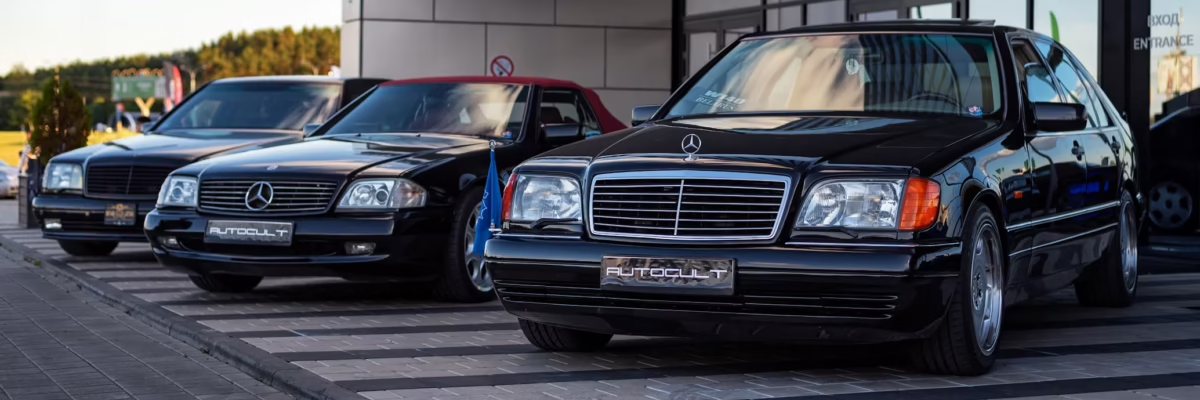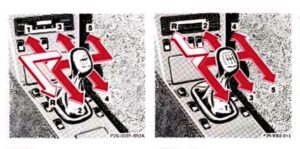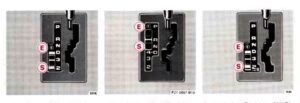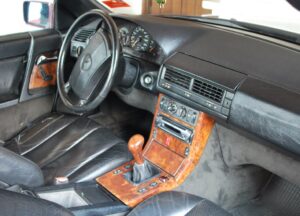Inside the Mercedes R129 SL transmission
1. Transmission options of the Mercedes R129 SL
2. Manual gearboxes: Precision and performance
3. Automatic transmissions: Comfort and refinement
4. The 500SL: Effortless power
6. ASR and ASD: Early active safety systems
7. Conclusion
Transmission options of the Mercedes R129 SL
When the Mercedes R129 SL debuted in 1989, it set new standards in luxury, performance, and innovation. A key part of its versatility and appeal came down to the variety of transmission options available across its model range—from silky-smooth automatics to engaging manual gearboxes. Let’s dive into the details of what made the R129’s transmission setup so distinct and advanced for its era.
Manual gearboxes: Precision and performance
The six-cylinder models—the 300SL and 300SL-24—came equipped with a five-speed manual gearbox (Type 717.4 series) as standard. This gearbox featured full synchromesh and a single dry-plate clutch, giving drivers a traditional, connected driving experience.
Interestingly, the 300SL featured a conventional H-pattern shift gate with fifth gear placed up and to the right, while reverse was down and to the left. The gear ratios were:
-
1st: 3.86
-
2nd: 2.18
-
3rd: 1.38
-
4th: 1.00
-
5th (Overdrive): 0.80
Matched with a 3.92:1 final drive, the base 300SL could hit 142 mph (228 km/h) and go from 0–60 mph in 9.3 seconds. Impressively, it achieved 33.1 mpg (UK) or 27.7 mpg (US) during steady cruising.
The more powerful 300SL-24 variant featured a unique dogleg gear pattern—first gear was to the left and down—with close-ratio gears optimized for the high-revving 24-valve engine:
-
1st: 4.15
-
2nd: 2.52
-
3rd: 1.69
-
4th: 1.24
-
5th: 1.00
Its taller final-drive ratio of 3.46:1 allowed a top speed of 150 mph (240 km/h) and a quicker 0–60 mph time of 8.4 seconds.
Automatic transmissions: Comfort and refinement
Optional on the 300SLs and standard on the V8-powered 500SL was the Type 722.3 four-speed automatic transmission. It came with a torque converter, Mercedes’ classic staggered gate layout, and a switch to toggle between “Standard” (sometimes labeled “Sport”) and “Economy” modes—though this switch was omitted on U.S.-bound models due to CAFE regulations.
Both the 300SL and 300SL-24 shared internal automatic gear ratios:
-
1st: 3.87
-
2nd: 2.25
-
3rd: 1.44
-
4th: 1.00
However, the final drives differed—3.29:1 for the 300SL and 3.46:1 for the 300SL-24. Despite being slightly slower, the automatic 300SL remained within 2% of the manual’s performance, though fuel economy dropped by about 8%. The 300SL-24 also showed a modest 7% fuel consumption increase, which Mercedes later addressed by introducing a five-speed automatic.
The 500SL: Effortless power
The 500SL came exclusively with the four-speed automatic, but its drivetrain was calibrated for torque and high-speed cruising. It used the same internal gear ratios but with a dramatically longer final-drive ratio of 2.65:1. That gave the car long legs and impressive efficiency for its class.
Performance was exhilarating: 0–60 mph in just 6.2 seconds and a governed top speed of 156 mph (250 km/h). Fuel economy was reasonable for a V8 grand tourer—27.9 mpg (UK) or 23.3 mpg (US) at steady highway speeds.
What about 4MATIC?
Interestingly, Mercedes considered equipping the R129 with its advanced 4MATIC all-wheel-drive system, then being introduced on the W124. The system automatically distributed power 35:65 front-to-rear when wheel slip was detected and included center and rear locking differentials.
However, the idea was dropped before production—likely due to cost, weight, and packaging concerns. In the end, Mercedes felt the SL’s inherent chassis balance didn’t need AWD, especially with the introduction of advanced traction technologies.
ASR and ASD: Early active safety systems
As part of Mercedes’ Fahrdynamik-Konzept (Driving Dynamics Concept), the R129 featured cutting-edge electronic aids:
-
ASR (Acceleration Slip Regulation): A true traction control system, ASR adjusted rear brake pressure and engine power to maintain grip. It was fully automatic, monitored cornering speeds, and disengaged when braking. There was even a snow chain mode—but no full-off switch.
-
ASD (Automatic Locking Differential): Available on four- and six-cylinder models, ASD hydraulically locked the rear diff up to 100% on slippery surfaces, automatically dialing back to 35% when grip returned or brakes were applied.
Both systems were optional at launch, though they didn’t reach the U.S. market until the 1991 model year.
Conclusion
From its range of precision-engineered manual and automatic gearboxes to its early adoption of traction-enhancing technologies, the Mercedes R129 SL was a masterclass in drivetrain engineering. Whether you valued the purity of a manual shift or the ease and intelligence of an automatic, the SL delivered performance and luxury in equal measure. Even decades later, its technical sophistication still impresses.
Are you already a proud owner of a Mercedes R129? If so, check out our selection of parts for this car at the following link:
Photos sources: automotorpad.com










